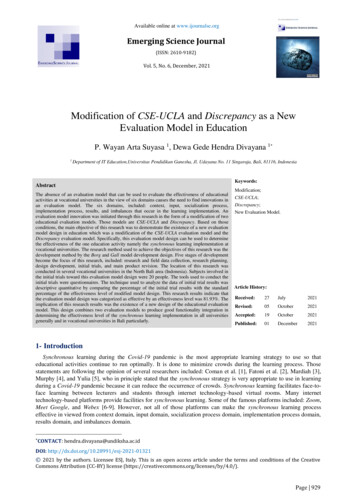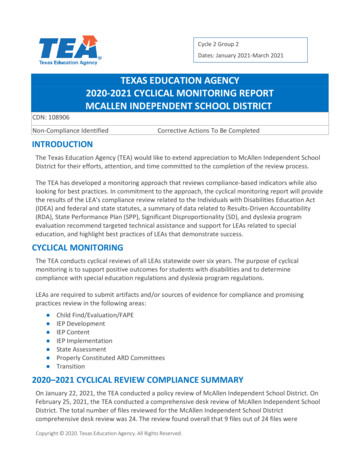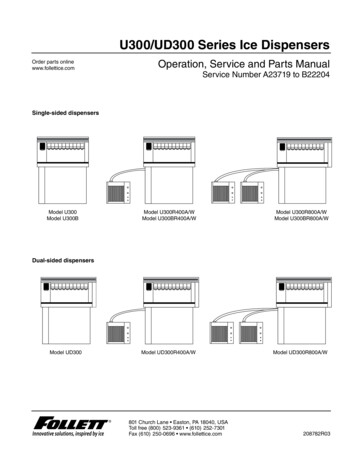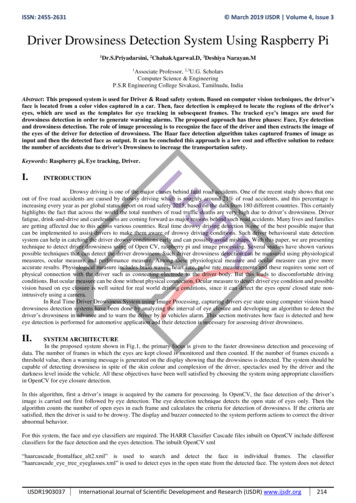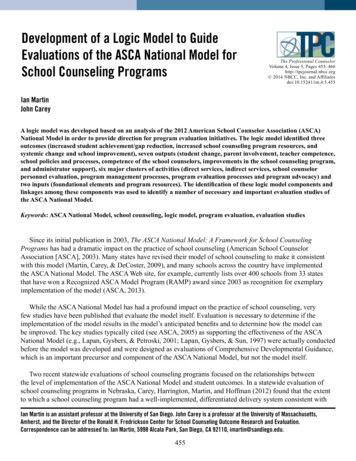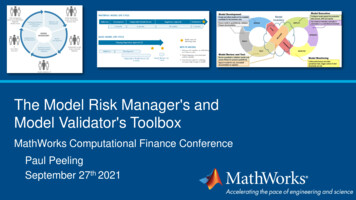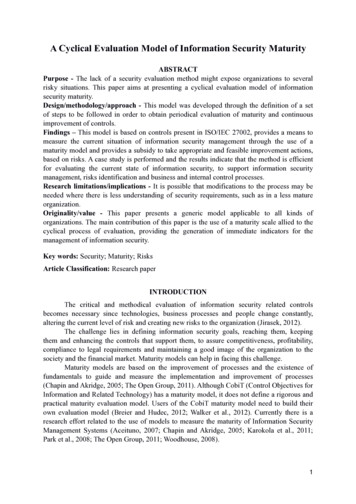
Transcription
A Cyclical Evaluation Model of Information Security Maturity!ABSTRACTPurpose - The lack of a security evaluation method might expose organizations to severalrisky situations. This paper aims at presenting a cyclical evaluation model of informationsecurity maturity.Design/methodology/approach - This model was developed through the definition of a setof steps to be followed in order to obtain periodical evaluation of maturity and continuousimprovement of controls.Findings – This model is based on controls present in ISO/IEC 27002, provides a means tomeasure the current situation of information security management through the use of amaturity model and provides a subsidy to take appropriate and feasible improvement actions,based on risks. A case study is performed and the results indicate that the method is efficientfor evaluating the current state of information security, to support information securitymanagement, risks identification and business and internal control processes.Research limitations/implications - It is possible that modifications to the process may beneeded where there is less understanding of security requirements, such as in a less matureorganization.Originality/value - This paper presents a generic model applicable to all kinds oforganizations. The main contribution of this paper is the use of a maturity scale allied to thecyclical process of evaluation, providing the generation of immediate indicators for themanagement of information security.!Key words: Security; Maturity; RisksArticle Classification: Research paper!INTRODUCTIONThe critical and methodical evaluation of information security related controlsbecomes necessary since technologies, business processes and people change constantly,altering the current level of risk and creating new risks to the organization (Jirasek, 2012).The challenge lies in defining information security goals, reaching them, keepingthem and enhancing the controls that support them, to assure competitiveness, profitability,compliance to legal requirements and maintaining a good image of the organization to thesociety and the financial market. Maturity models can help in facing this challenge.Maturity models are based on the improvement of processes and the existence offundamentals to guide and measure the implementation and improvement of processes(Chapin and Akridge, 2005; The Open Group, 2011). Although CobiT (Control Objectives forInformation and Related Technology) has a maturity model, it does not define a rigorous andpractical maturity evaluation model. Users of the CobiT maturity model need to build theirown evaluation model (Breier and Hudec, 2012; Walker et al., 2012). Currently there is aresearch effort related to the use of models to measure the maturity of Information SecurityManagement Systems (Aceituno, 2007; Chapin and Akridge, 2005; Karokola et al., 2011;Park et al., 2008; The Open Group, 2011; Woodhouse, 2008).!1
This paper proposes a method for information security management through aperiodic evaluation of maturity and continuous improvement of controls. The proposedmodel is generic and applicable to all kinds of organizations, using the ISO/IEC 27002security controls (ISO, 2005b) related to the analysis of risk and the evolution of theenvironment.The paper is organized in seven sections. Section 2 presents the main related works.Section 3 presents the main technical standards related to information security and riskmanagement. Section 4 describes basic concepts of maturity models. In section 5, a cyclicalevaluation model of information security maturity is proposed. Section 6 presents a casestudy in which the model was applied in an organization to verify its effectiveness. The lastsection presents the conclusions.!RELATED WORKThe work of Karokola et al. (2011) describes a proposal of information securitymaturity model (ISMM) for secure e-government services (implementation and servicedelivery). Basically, the model is based on the findings from the critical analysis ofinformation security maturity models of the literature. Five maturity levels with theirrespective security control dimensions were defined: level 1 (undefined), level 2 (defined),level 3 (managed), level 4 (controlled) and level 5 (optimized). Maturity level 1 is the lowestand maturity level 5 is the highest. This paper is a theoretical proposal and does not show acase study of application of the proposed model. The paper is limited to defining five levelsto evaluate the maturity of an information security management system specifically forsecure e-government services, without presenting a method for the measurement of thecurrent situation of security or the monitoring and evolution of security and related processes.In the study of Dzazali et al. (2009), the researchers attempt to evaluate theinformation security maturity level of the Malaysian Public Service organizations. Thisresearch uses CobiT maturity levels as the base. This study uses data collected from 970targeted individuals through a self-administrated questionnaire. Findings on the maturitylevel show that 21% of respondents are at Level 2, 61% are at Level 3, followed by 13 % atLevel 4 and 1% at Level 5. It is an exploratory study, of qualitative nature, with theapplication of questionnaires. The study of Dzazali et al. (2009) presents specific and staticpropositions, which may preclude the evaluator conducting proper risk analysis astechnologies, business processes or external requirements evolve.The main difference between the cited works (Dzazali et al., 2009; Karokola et al.,2011) and this paper is that in this paper we present a management process for the continuousimprovement of security, in the form of a generic model applicable to all kinds oforganizations, regardless of size or field, using the 133 information security controls presentin the ISO/IEC 27002 standard.The work of Woodhouse et al. (2008) is similar to this one in the sense that it does notuse a methodology based on generic checklists created based on technical controls. However,Woodhouse et al. (2008) does not present a method to effectively measure and find out thelevel of information security maturity.Park et al. (2008) presents a way to measure maturity in the management ofinformation technology services and uses the IT Infrastructure Library (ITIL) as a foundation.The paper shows the phases of interviews of persons in charge, measurements of maturityand the results of measurement. The model of Park et al. (2008) presents the limitations of!2
evaluating security under the scope of Service Support and Service Delivery processes, whichare essentially linked to Information Technology, it does not allow for an analysis ofinformation security risks generated in business processes not essentially related to IT.!MAIN TECHNICAL STANDARDS RELATED TO INFORMATION SECURITYThe main normative references are the standards in the “27000 family” from theInternational Organization for Standardization (ISO), which are specific for the managementof information security (Cowan, 2011).ISO/IEC 27001:2005 – its goal is “to provide a model for establishing, implementing,operating, monitoring, reviewing, maintaining and improving an Information SecurityManagement System (ISMS)” (ISO, 2005a).ISO/IEC 27002:2005 - it is the foundation standard for information security. The goalof this standard is to establish guidelines to establish, implement, maintain and improveinformation security management, through the definition of controls that may be used to meetrequirements identified by risk assessment (ISO, 2005b). The standard is structured in 11sections of information security controls, divided in 39 main security categories and oneintroductory section that addresses the assessment and treatment of risks. 133 controlsapplicable to information security are defined. The standard is not perfect and foresees thatorganizations may have to use more controls than those presented. Every activity in anorganization involves risks that have to be identified, analyzed and assessed to establish ifthey need treatment. This review is exactly what will determine the need for changes and theprioritization of these changes according to requirements that must be met by theorganization.ISO/IEC 27005 provides guidelines for information security risk assessment (ISO,2008). Figure 1 presents a schematic view of the information security risk managementprocess according to ISO/IEC 27005.!3
!Figure 1. Information security risk management process (adapted from ISO (2008)).!SECURITY MATURITY MODELSA security maturity model provides a guide for a full security program. It also definesthe order in which security elements must be implemented, encourages the use of standardsof best practices and provides a means to compare security programs (Chapin and Akridge,2005; The Open Group, 2011).After identifying critical processes and controls, the use of a maturity model allowsthe identification of gaps that represent risk and how to show them to management team.Based on this analysis, action plans can be evaluated and developed for the improvement ofprocesses and controls considered deficient up to the desired development level (ITGI, 2007;Jirasek, 2012).Some approaches of information security management standards can be classified inthe following way: process oriented, such as CobiT and ITIL; control oriented, such as ISO27001; product oriented such as Common Criteria (ISO 15408); risk management oriented,such as OCTAVE and ISO 27005 and best practices oriented, such as ISO 27002. Aceituno(2007) defines a maturity model for information security management, currently called OISM3 and compatible with the ISO 27001 standard.!4
The two most important maturity models considered in this work are CobiT and OISM3. The COBIT maturity model is widely used for IT governance. The O-ISM3 model isspecific to management of information security. In Karokola et al. (2011), other maturitymodels are described, but these were not considered, since they do not present measuringaspects.!CobiT Maturity ModelCobiT presents a set of indicators obtained by the consensus of experts, which aremore focused on the controls of activities than in their execution. These controls assist inoptimizing the IT investment, ensure service delivery and provide a measure to passjudgment and allow comparison.The information security management model presented in this paper has itsmeasurement basis supported by the maturity scale of CobiT (Figure 2).!!Figure 2. Graphic representation of the maturity model used in CobiT (adapted from ITGI(2007)).!The maturity scale used in this paper is presented in Table 1.!LevelCharacteristics0 Non-existentComplete lack of any recognizable processes. The enterprise has noteven recognized that there is an issue to be addressed1 Initial/Ad-hocThere is evidence that the enterprise has recognized that the issues existand need to be addressed. There are, however, no standardizedprocesses; instead, there are ad hoc approaches. The overall approach tomanagement is disorganized.!5
LevelCharacteristics2 Repeatable but Processes have been developed until the point where similar proceduresIntuitiveare followed by different people undertaking the same task. There is noformal training or communication of standard procedures, andresponsibility is left to the individual. There is a high degree of relianceon the knowledge of individuals and, therefore, errors are likely.3 D e f i n e d Procedures have been standardized and documented, and communicatedProcessthrough training. It is mandated that these processes should be followed;however, it is unlikely that deviations will be detected. The proceduresthemselves are not sophisticated but are the formalization of existingpractices.4 Managed and Management monitors and measures compliance with procedures andMeasurabletakes actions where processes appear not to be working effectively.Processes are under constant improvement and provide good practice.Automation and tools are used in a limited or fragmented way.5 OptimizedProcesses have been refined to a level of good practice, based on theresults of continuous improvement and maturity modelling with otherenterprises. IT is used in an integrated way to automate the workflow.Table 1. Scale used for maturity levels (adapted from ITGI (2007))!Users of CobiT need to build their own evaluation model, according to the granularity ofthe processes, since the maturity model does not define a practical evaluation model (Breierand Hudec, 2012; Walker et al., 2012).!O-ISM3 Maturity ModelThe O-ISM3 (The Open Group Information Security Management Maturity Model) isan information security management maturity model with five levels: undefined, defined,managed, controlled and optimized (The Open Group, 2011). The model development isgrounded on CMMI, ITIL, ISO 9000, and ISO 17799/27001. However, ISM3 does notmeasure risk or security directly (Karokola et al., 2011).!THE MODEL OF EVALUATION BY MATURITY LEVELSThe model presented in this paper aims to evaluate information security in a wayconsistent with organizational goals. The main characteristics of the model are:1. Being structured in the form of a management process that allows continuousevaluation and improvement, through the use of the ISO/IEC 27001 standard;2. Being based on controls that are appropriate for information security, through the useof the ISO/IEC 27002 standard;3. Providing a means to measure the current situation of information securitymanagement and its evolution over time, through the use of a maturity model; and4. Providing support for appropriate and feasible improvement actions, based on risks,supported by the use of the ISO/IEC 27005 standard.!!6
Evaluation and continuous improvementSince risks are dynamic, information security requirements are constantly changing.The use of PDCA (Plan-Do-Check-Act) model adopted by ISO/IEC 27001 encourages theISMS administrative users to highlight the importance of continuous improvement based onobjective measures.!Information security controlsThe evaluation model in this paper uses the structure of controls from the ISO/IEC27002 standard. The standard defines 133 controls that can be evaluated.!Measurement and monitoringThe information security management system presented in this article has its basemeasurement supported on the COBIT maturity scale (Figure 2 and Table 1).!Stages of the cycle of evaluation and continuous improvementThis paper contributes in proposing stages of the cycle of maturity assessment andimprovement of information security (Figure 3), since CobiT does not define a practicalmodel for assessing the maturity and users need to build their own evaluation model (Breierand Hudec, 2012; Walker et al., 2012).One metric, or indicator, by itself is not the answer to manage IS (InformationSecurity) issues in an organization. Besides measuring, there must be action on the problemsfound and monitoring on the evolution over time. Figure 3 presents the eight stages thatcomprise the proposed cycle of evaluation of information security maturity.!!!Figure 3. Proposal of stages of the cycle of evaluation and improvement of informationsecurity (IS)!Each of these stages is described in more detail below.1. Definition of the scope of evaluationAn organization may have, simultaneously, administrative, industrial or serviceproviding activities, or may be geographically distributed, and consider convenient to dividethe evaluation of security maturity in parts.!7
The definition of scope consists in identifying areas, technologies and processes of theorganization that will be included in the evaluation (ISO, 2005a).!2. Global analysis of risks related to information securityThis model uses the qualitative method (Harris, 2012; ISO, 2008) for risk analysis,through the use of a scale with qualifying attributes that describe the magnitude of potentialconsequences (impact) and the probability that these consequences may occur (as presentedin Figure 4). The method of information gathering uses interviews with at least two people:one with experience in risk analysis and the other with the domain knowledge. Participants ofthe interview define risks and for each risk the probability and impact are identified, in orderto realize the risk analysis. This approach was considered sufficient for the identification ofrisks and to support the choice of controls to be evaluated.!3. Selection of information security controlsIn this stage information security controls present in ISO/IEC 27002 are chosen whenconsidered applicable for covering the risks identified in the information security riskanalysis stage. From the risk analysis, the goal maturity level (or envisaged level) is definedfor each security control in order to keep risk at an acceptable level.Although the model uses the control structure of ISO/IEC 27002 as a basis forevaluation, organizations must be capable of identifying other controls, considering, forinstance, corporate risk analysis or best practices adopted in the field in which theorganization operates.!4. Planning of the analysis of information security controlsIn this stage planning for the analysis and evaluation of controls considered applicableand their respective control activities will be performed. The purpose of this stage is toidentify and commit the parties involved, identify stakeholders, define a schedule forevaluation activities in the cycle and create a communication plan for the results obtained.!5. Analysis and maturity evaluation of information security controlsProcesses and activities carry out security controls. Thus, we can measure the maturityof the processes by measuring the maturity of the related individual controls. A singlesecurity control can also be present in distinct processes of an organization.In this stage the maturity level of each control will be compared to the risk analysisand, if necessary, actions must be proposed for the correction or improvement of relatedactivities. This stage is divided in the following five steps (represented in Figure 4):a) Identification of related processes and activities: the information security controls areaccomplished in the activities of business, operational (task execution) or control(verification or approval of the executed task) processes. This step consists of identifying andrelating to the selected security controls, every process, procedure and activity that contributeto its accomplishment;b) Analysis of the maturity level of the control: based on the processes and activitiesthat support the evaluated control, ascertain the maturity level of the control according to thematurity scale used by the model. Each control can be present in distinct processes/activitiesand in each process/activity the same control can have a different level of the goal maturitylevel and of the evaluated maturity level.!8
c) Evaluation of the maturity level of the control: in this step it will be evaluated if thematurity of the control, ascertained by the set of activities that support it, is consistent withthe maturity necessary to treat business related risks (defined as the goal maturity level);d) Definition of necessary improvements: based on possible deficiencies found in theaccomplishment of controls, in this step the actions and improvements in activities related tothe security control, or even the creation of new control activities to keep the risk at anacceptable level, will be documented;e) Communication of results to those responsible for the control: in this step the resultsof the analysis of the security control are communicated to those responsible, so that they areaware and can assess the necessary actions and possible emergency interventions.!!!!Figure 4. Proposal of steps in the maturity evaluation of information security controls6. Consolidation of information security action plansIt is reasonable to expect that many control objectives may have common actionplans. In this stage all the proposed improvements will be consolidated and organizedaccording to the processes and business activities to which they are related. This stage isdivided in four steps:a) Review and organization of identified improvements: this step aims to create anintegrated view of all the improvement actions necessary to reduce the implementation effort,since similar changes may be identified and proposed in different controls;!9
b) Definition of responsibilities for execution: the goal of this step is to appoint, foreach proposed action plan, a person responsible for its execution and monitoring;c) Approval of action plans: in this step, the prioritization, the approval and theplanning of action plans are performed;d) Communication of action plans: in this step the action plans are communicated tothose responsible, to make them aware of the work to be done.The organization must “update security plans to take into account the findings ofmonitoring and reviewing activities” (ISO, 2005a).!7. Monitoring of information security action plansIn this stage a monitoring of the execution of action plans will be performed, to verifythe meeting of deadlines and evaluate possible problems in execution.!8. Closing, documentation and reportingIn this stage the actions performed during the evaluation cycle are registered and theoperational and management reports are issued. Also, the evolution of the maturity level ofthe controls is documented.The closing documentation must be complete enough to demonstrate the evolution ofinformation security, raise the awareness of management to the main remaining attentionpoints and risks, justify the need for resources to enhance the level of security and base thecritical analysis of improvement of the ISMS.!CASE STUDY OF THE EVALUATION OF INFORMATION SECURITY MATURITYA case study was performed for the application of the model of evaluation ofinformation security maturity level. The organization that participated in the study is real, butwill be named CompanyX.The chosen scope of evaluation was the set of administrative processes and activitiesof the organization. The organization had already performed, previously, information securityevaluations with a method similar to the described in this paper, which facilitated the tasks ofevaluation and reduced the time of analysis.At the beginning of the study, the evaluated organization did not have a formalevaluation of risks specifically related to information security. It was considered that acomplete analysis of information security controls would be adequate for calculating thecurrent maturity level and identification of unknown risks.Initially, because of the great extension of business processes of the organization, itwas decided to consider applicable most of the information security controls proposed inISO/IEC 27002. Control 10.9.1 – Electronic Commerce – was the only control excluded fromthe scope of analysis, because the organization does not practice this kind of activity.The evaluation of controls was performed by the person in charge of information security,with the possibility of consulting experts in each area. The analyses and assessments wererecorded in a spreadsheet. For each of the security controls of ISO/IEC 27002, the evaluationspreadsheet had fields that were filled with the following data: the current level of maturity,the goal maturity level, the name of the evaluator(s), the date of the last evaluation, theprocesses and the related activities to each control and the suggested plans of action.As an example, we selected the control 11.2.4 – Review of user access rights, controlobjective 11.2 – User access management. According to ISO/IEC 27002, “management!10
should review users’ access rights at regular intervals using a formal process”, to maintain aneffective control over accesses. Activities performed in the five stages of evaluation were:1. Identification of related processes and activities: the organization had a semiannualprocess for reviewing access rights to the computing environment. The whole reviewprocess was formalized in a process and the Information Security Policy. People incharge of the review had been trained and support material was available. The processcoordinator was the person responsible for information security. However, the requestfor the review and the review conclusion were conducted via e-mail, with littlecontrol over the execution of the process;2. Analysis of the maturity level of the control: according to the maturity scale used inthis work, the existence of a formally defined and approved process, with identifiedresponsibilities and training of people involved characterizes the maturity level 3 –Defined;3. Evaluation of the maturity level of the control: because the organization was subjectto control requirements in its IT processes, it needed to show a control over the accessrights review process was in place. As a consequence the organization considerednecessary to improve the access rights review process to achieve level 4 - Managed;4. Definition of necessary improvements: to reach maturity level 4 (managed) thefollowing actions were suggested:I. Develop a system to register every user access rights review cycle;II. Modify the review process so that there was a documented evidence over thereviews and the actions taken if some system, module or environment does nothave its review process finished in the specified time;III. Formally communicate the person responsible that does not have its reviewprocess finished in the specified time; andIV. Formally communicate the IT and internal audit managers about themonitoring of the process and the completion of the review cycle.5. Communication of results to those responsible for the control: the proposed actionswere documented and forwarded to the IT manager and internal audit.!After the completion of the evaluation of the maturity level of every selected control, theproposed actions originated action plans. The action plans that did not need financialresources were selected to be executed first. The action plans that needed financial resourcesor demanded greater changes in the processes were selected to be monitored by theorganization. At each new evaluation cycle the applicable controls will be reevaluated and theaction plans revised.Table 2 presents the results of the average maturity levels obtained from the evaluationspreadsheet filled with data from the current maturity level for each evaluated section of theISO/IEC 27002.!SectionDescription – ISO/IEC 27002A v e r a g ematurity5Security Policy3.176Organizing information security2.78!11
SectionDescription – ISO/IEC 27002A v e r a g ematurity7Asset management2.558Human resources security2.359Physical and environmental security3.2410Communications and operations management2.6111Access control2.5912Information systems acquisition, development and 2.80maintenance13Information security incident management1.5514Business continuity management2.0215Compliance2.24Table 2. Average maturity levels ascertained!Figure 5 presents the visualization of calculated average maturity levels.!!Figure 5. Visualization of average maturity levels ascertained in the case study!!12
Through the analysis of the results obtained, the organization is considered to have anaverage maturity level of 2.54. It indicates that, on average, their information security relatedprocesses are being structured to be formally defined. The organization considers that most oftheir processes have a maturity level adequate to its reality, and the main controls related tocompliance to external requirements are classified in levels 3 or 4. Several action planscreated aimed at small improvements in processes, not necessarily related to a maturity levelimprovement.According to the perception of the organization, the method of evaluation of controlsof the ISO/IEC 27002 standard by means of maturity levels provided some benefits,according to a report by the IT manager: “This method will not be used only as a form ofisolated evaluation, but as an instrument of management for the security of our information.Besides providing a picture of the current scenario of our controls, the method provides thecreation of documentation for the evaluation and direction of efforts for the improvement ofsecurity. Many improvement actions were identified with the individual evaluation of eachcontrol item, and the maturity model aids in its prioritization”.!CONCLUSIONThe detailing of a method for the management of information security throughperiodical evaluation of maturity and continuous improvement of controls was shown. Theuse of the maturity scale allied to the cyclical process of evaluation provided the generationof instantaneous and temporal indicators for the management of information security.The similarity between this paper and the related works presented is in the use of theISO/IEC 27002 standard and a maturity model. The main difference lies in the fact that theproposed models present propositions that are specific, static, which may preclude theevaluator the proper analysis of risks inherent to the business as there is an evolution of theenvironment. Another significant difference is that this paper seeks to define a genericevaluation model, applicable to all kinds of organization, through the use of all the controlobjectives of the ISO/IEC 27002 standard.The use of models with propositions that are static and specific to a given sector maybe considered useful for beginner or inexperienced evaluators, since it may contain examplesof what could be done to improve their security processes; still, they limit the evaluation tothe proposed issues to the vision of the creator and to the time when they were created. Theuse of a generic model can be inadequate for beginner evaluators, who must first understandand interpret the standards; however, they provide to an experienced evaluator room foradjustments
the processes, since the maturity model does not define a practical evaluation model (Breier and Hudec, 2012; Walker et al., 2012). ! O-ISM3 Maturity Model The O-ISM3 (The Open Group Information Security Management Maturity Model) is an information security management maturity model with five levels: undefined, defined,


